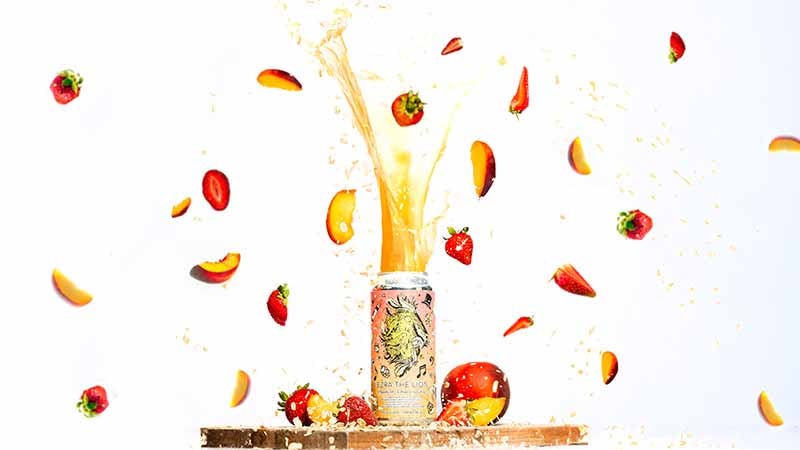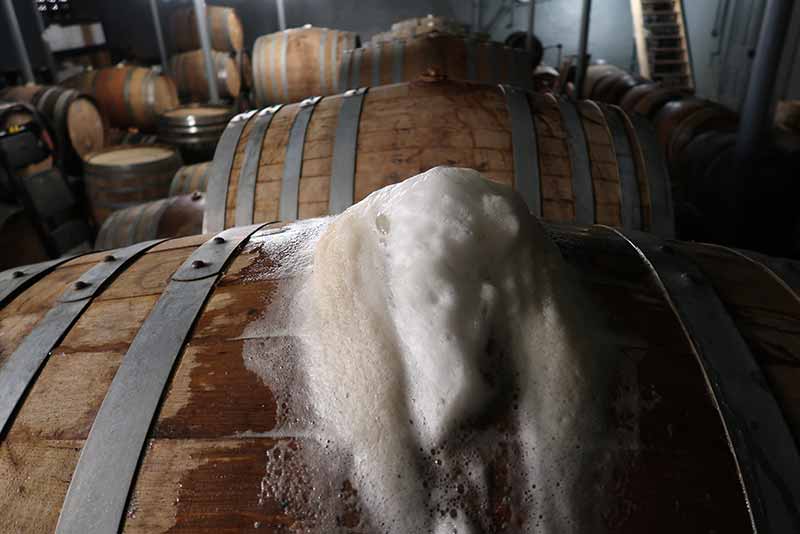
We’re officially into spring now, and the change in the seasons requires more refreshing beer. We’ve written much about sour beers, including the smoothie and kettle varieties. Along those lines, a Berliner weisse can provide the tartness and drinkability that hits the spot for consumers as we head into warmer months.
While the Berliner weisse—a tart wheat ale with its origins traced back to Berlin—is a classic beer, there are ways to create a great one, even if you veer off the traditional path. We chatted with The Referend Bier Blendery and Hidden Springs Ale Works, both makers of great Berliner weisse-adjacent beers, to learn top considerations, how to achieve the ideal souring, and the appropriate ABV for the style.
(Above photography courtesy of Hidden Springs Ale Works)
Affordable, Industry-Leading Brewery Software
How Do the Experts Define a Berliner Weisse?

Photography courtesy of Hidden Springs Ale Works
Traditionally, there are two key components of a Berliner weisse. In German, weisse means wheat, which can typically make up fifty percent of the grain bill. The other key component includes a souring element, usually from a bacteria strain like Saccharomyces, Brettanomyces, or Lactobacillus.
Hidden Springs Co-Owner Joshua Garman says they make something more like a “Florida weisse”—essentially pairing fruit to the traditional Berliner weisse—or a pastry sour than that of the authentic route. He admits they have made one or two conventional takes on the style, and there is a specific profile he looks for in the finished product.
“I think that Berliner weisse needs a crisp—not acidic—tartness like a lemonade [more than] than you would get out of a Belgian sour, which is more vinegary,” Garman says. “You want that crisp, bright tartness from it.”
The Referend Owner James Priest says they only practice spontaneous fermentation at his facility, so he barely considers his a Berliner weisse. He calls it more of a modern type.
“We took a different approach, from the perspective of a lambic brewery; we wondered how to approach that wheat, low ABV, and that type of acidity [found in Berliner weisse],” Priest says.
He adds, “We are after a cleaner, brighter acidity. A ‘session-grade Berliner weisse.’ That is a little pale wheat beer at 3.5% ABV that ideally gets out of its own way, is refreshing and effervescent, and you want to drink a lot of it despite its strong complexity.”
Priest notes that he sees Berliner weisse becoming more like a saison, but “the through line is still true.”
What Are Some Expert Tips for Making Berliner Weisse?

Photography courtesy of Hidden Springs Ale Works
While saying he wouldn’t recommend his own Berliner weisse processes unless someone is trying to emulate it, Priest believes he has some tricks up his sleeve to make a great one.
“We use all raw wheat instead of malted wheat,” Priest says.”We also use low-alpha, whole-leaf aged hops. That helps with the pH and keeps the IBUs down, so the lactobacillus can still thrive.”
Priest adds, “Every great Berliner weisse should have Saccharomyces and Brettanomyces to dry out and ideally is the hallmark for cellarability.”
Garman says he’s been making the style for thirteen years, and his approach has changed over the years as the strains of bacteria have expanded.
“When we started, there were only one or two strains of lactobacillus,” Garman says. “Now it’s like six to twelve types readily available for brewers to use.”
Picking the right strain is paramount.
“You’re going to need to do some homework to find the right strain,” he says. “Look at the different varieties of lactobacillus and find the strain that will give you the flavor you’re looking for.”
Which Souring Method Is Best for Berliner Weisse?

Photography courtesy of The Referend Bier BlenderyGarman says that kettle souring is the more traditional method for creating the tartness of a Berliner weisse, but innovations like Sourvisiae and Philly Sour yeast strains have provided brewers with another option.
“The Sourvisiae or Philly Sour strain will work well and give you the tartness you need,” says Garman. “It’s easier and less complex.”
Garman adds, “If you want to do the traditional two-ferment kettle sour method, use lactobacillus, and you’ll get a better result.”
Garman says that about eighty percent of the beer he brews is sour, so tying up the kettle for several days is challenging. Instead, he kicks it over to a tank for souring and then sends it back to the kettle to boil. Hidden Springs had been using Sourvisiae but returned to traditional methods because he said he noticed a change in beer quality four to six months out.
“We did the Sourvisiae for about six months. Once we noticed it changes dramatically, that was my biggest concern,” Garman says. “That’s when we went back to adopting traditional methods.”
Priest sours through spontaneous fermentation, sending his beer into a coolship for about six hours after the boil to collect all the natural bacteria.
“We have it come down to about 120 to 125 degrees Fahrenheit in the coolship,” Priest says. “For pre-fermentation, we pull it out of the coolship while still warm and hold it warm in totes.”
Priest adds, “The way we do it, there is a lot of seasonal focus. We want it to be cold out, but not too cold, so the acidification can get out ahead of the yeast insertion.”
Where Should the pH Land for Berliner Weisse?

Photography courtesy of Hidden Springs Ale Works
Priest says that with his method, he can’t precisely control the pH, but notes that when the wild yeast is active, the pH drops two points to the upper threes or low fours.
“There’s just inherent variation, and it’s surprising that, as long as the acidification goes well and quickly to get down to the upper threes on pH, they have a commonality,” Priest says. “Most of the control in the pH we try to achieve in blending finished barrels.”
Garman adds that you need to dial in managing the pH level of the final product.
“It’ll take a handful of batches to find where you want to stop the tartness,” Garman says. “If you want super tart, let the lactobacillus work for a couple of hours to days, depending on ferment and pitch.”
He says that the proverbial sweet spot—or tart spot—is up to the brewer.
“I’ve seen them as low as 2.7 or 2.8 pH, which is insane,” Garman says. “For me, a 2.8 to 2.9 pH range is nice in hot summer months—like drinking lemonade. But if that’s not what you’re going for, you’ll need to stop that lacto much sooner.”
What Is an Ideal Grist for Berliner Weisse?

Photography courtesy of The Referend Bier Blendery
The Berliner weisse is more about tartness and less about a complex grain bill. As the name says, the beer has to have a bit of wheat (weisse is German for wheat).
Garman goes with a traditional sixty-forty split of base malt and wheat.
“We don’t drift from that. We tend to stay in that range, and that tends to be pretty good,” he says. “We use some rice hulls, too, for good measure.”
Garman says they mash on the low end, around 148 degrees Fahrenheit to 150 degrees Fahrenheit, and knockout at 85 to 90 degrees Fahrenheit to the lacto tank—or the kettle if you whirlpool.
“We check in pH at the eighteen-hour mark and see how it’s progressed,” Garman says. “We are looking for a pH of 3.1 to 3.3 depending on the beer we’re making. And once we hit that, we go to boil.”
He adds, “Once you dial it in, it’s pretty repeatable. It’s a workhorse.”
The Referend inverts its lambic recipe for the Berliner weisse, using sixty to sixty-five percent raw wheat and thirty to thirty-five percent local pilsner malts.
“Grist-wise, it couldn’t be easier,” Priest says. “For the mash, we do more of a traditional turbid mash.”
Priest says they do three total turbid pulls where they mash in at 100 degrees Fahrenheit, then rest, then to 133 degrees Fahrenheit, another rest at 148 degrees Fahrenheit, and a final at 165 degrees Fahrenheit.
Which Hops Are Best for a Berliner Weisse?
Priest says that because their boil is so short—anywhere from fifteen to forty minutes—they sometimes do mash hopping. With the turbid mashing, he says they throw mash hops in at the 165-degree raise and rest.
“We use low original alpha hops, anywhere from two- to ten-year-old whole-leaf,” Priest says. “Crystal has been our most common one. Depending on the season and what we think is the health of the ambient bacterial population, we go as low as three and a half pounds and as high as five pounds in ten barrels.”

Photography courtesy of Hidden Springs Ale Works
He adds, “If you use aged pellets, definitely go on the low end because they can be more bitter. It should not be a real perceivable aspect of a Berliner weisse. It should just be a gentle or softer structure.”
Garman doesn’t put too much stock into hops for his Berliner weisse, opting for a dusting of noble hops.
“We do a small flameout addition of a half pound in a fifteen-barrel batch,” Garman says. “Traditionally, we do sixty-minute and ten-minute [additions], but we put a bunch of fruit in it to flavor it.”
What is the ABV Sweet Spot for Berliner Weisse?
Traditional Berliner weisse beers are very low in ABV.
“Ours are higher, at about 5.5% ABV,” Garman says. “If you want traditional, 2% to 3% ABV is about average. You’ll have some pushback on lower ABV [from consumers], but our Berliner weisse is our top-selling style.”
He adds, “Those beers work really well in Florida. Add tropical fruit, and it’s nice to drink on the beach.”
Priest would love to shoot more for sub-3% ABV, but his process lacks the control. He says he doesn’t make any gravity adjustments.
“I think if I had more control and I was pitching reliable cultures and I wasn’t risking a wild fermentation, I would push the ABV lower to a 2.5% or 2.7% ABV,” he says. “But with the risks of spontaneous fermentation, 3.5% ABV feels like a good middle ground. It’s still in the realm of the historical Berliner weisse.”
Two Great Examples of a Berliner Weisse

Photography courtesy of Hidden Springs Ale Works
The Referend has Berliner Messe, a 4% ABV, which is entirely spontaneously fermented and then aged in oak barrels. He says the average age through blending is nine to twelve months.
“We call it an accidental flagship,” Priest says. “When we were conceiving this beer, we didn’t think it would be all that interesting for people. It’s the single beer we make the most.”
Hidden Springs has its Riot Juice, a fruitier sour Garman calls a Florida weisse. It’s among the brewery’s core beers, 5.5% ABV, and features blackberry, lime, vanilla, and lactose.
“We brew ninety barrels a month,” Garman says. “And sell quite a bit of it.”



